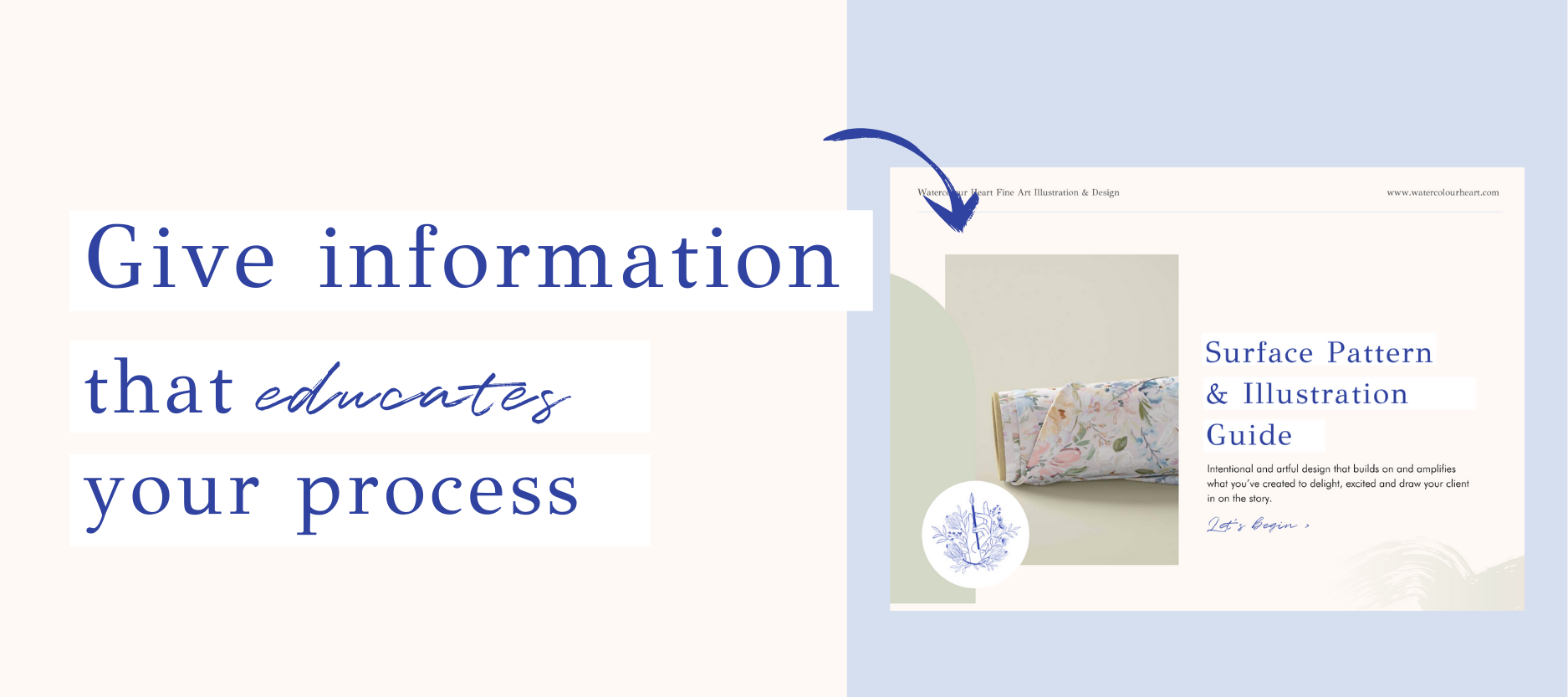READ OR LEAVE A COMMENT
SHARE POST

When you send out that first invoice and your side-hustle all of a sudden feels like the big-leagues or you’re making the leap from part-time to a full-time wearer of all the hats, having a clear understanding of what experience you’re crafting for your clients is so important.
I know so many illustrators/designers/part-time painters struggle with this because they feel it’s almost impossible to create a process when every project and every client is so unique and different. I totally get it and I’ve been there! While I have niched down substantially from when I started my business, my clients and the work I do for them can be very exclusive based on their needs.
Let’s break down how we can improve the experience of custom inquiries and communication so that potential clients feel like we truly care about them (because we do) without losing our minds and composure by bending over backwards every time someone sends a DM or inquiry email.
We’re starting with the inquiry phase because it sets the tone for your process, it’s your first introduction and it’s the part you can really streamline and make effortless instead of overwhelming in a way that leaves the potential client hanging (I was especially guilty of this in the beginning) or like you’re not sure what you can offer. Use this checklist and these tips for transforming your responses from unclear and hesitant to confident and clear!
📫Answer an inquiry with information that educates your process
This could be a curated PDF or drafted/canned emails that tell your potential client who you are, where your value is a.k.a why hire you, if you’re a good fit for what they are looking for and an outline of what they can expect in the process. You know what your frequently asked questions are, so write them all out and have them ready to copy and paste where appropriate so you’re not tearing your hair out for writing it out for the 100th time.
📬An educated potential client is a dream actual client
Custom projects are all unique but the thread that should run consistently through them all is how you carry your client through the process from start to finish starting off with educating them well. If they know what to expect from you, know how long it will take and what it will cost them there’s no technical ambiguity when the project has started and you can focus on doing good work. It also helps you set clear boundaries of what is included in your offering and stops you from being ‘annoyed’ when they ask for another change to the artwork when you never told them how many were included for your time in the first place. Educating from the get go opens doors for you to fully respect and serve your client to the best of your ability, valuing them and the process.
📮What does educating a client look like?
Below are some generally drafted examples that you could borrow and tweak to set up your inquiry PDF or canned emails. Creating templates for yourself to use, in your voice doesn’t mean that you don’t care to type something out from scratch every time – it means that you value promptness and the energy you have to bring a project to life while not becoming impatient with FAQ.
1. 👋Let them know who you are
E.g I am X from Y and I specialise in watercolour and portrait illustration. I am proficient in both traditional painting methods and digitising artwork so I am able to offer both physical paintings and digital files for print. I am passionate about creating artworks that tell stories and make everyday moments from the ordinary to the extraordinary frame-worthy for generations to come.
You should also include here if you have any specialised training or a particular list of skills.
2. 🏆Information that shows your value
This could be a gallery of past work paired with written reviews from previous clients that speak to the quality of your work. (If you haven’t asked clients for reviews -definitely go do that).
3. 👯♀️Information that makes it easy to screen if you are a good fit & call to action
This could be a number of things but often a good fit comes down to the value of deliverables, budget and timelines. A call to action will help clearly identify if you are a good fit, this may be filling out a set questionnaire or asking them to send reference images, colour palette and size of the artwork in order for you to give an accurate quotation.
E.g Illustrator: While each Portrait Illustrations are quoted individually single portraits start at X. Your investment is deeply valued and I strive to create a piece that not only meets your expectation but speaks to [insert certain values that your ideal client may have e.g your value for family and this special occasion]. Timelines are [insert timeline] and for physical illustrations, a flat rate of [X] will be added to your invoice or [X] if you are located in [name area]
E.g Freelance designer: I understand that making this kind of investment for your business is significant and I hold the responsibility of bringing this work to life with the highest esteem. While each project is quoted and packaged individually I maintain a rate of X per hour and may charge an additional rush fee for any work required under 48 hours.
4. 🧐Outline expectations
This is so that potential clients know exactly where they will be in the process, what they are in for and what they can expect from you. For large commissions and design work, these expectations should ideally be outlined in a contract that is signed by both parties. The only surprises they should get are being blown away by your talent!
E.g Once you have filled in the project questionnaire and you accept your quotation based on your needs a 50% deposit will be required to book your design/illustration slot. From deposit first drafts will be provided via email after [insert timeline] each project includes [X revisions] so if further revisions are required an additional charge will be added to the final invoice before the artwork is sent/released. I will always let you know at this point what additional charges may be if you should need further revisions, so you have the agency to go ahead with them or not. You can see an outline of the process below:
Step 1: Deposit to secure booking
Step 2: First draft
Step 3: Feedback and Revision
Step 4: Second draft
Step 5: Feedback and Revision
Step 6: Final tweaks and project presentation
Step 7: Sign-off and final payment
Step 8: Delivery of the artwork/files
Composing a PDF, text or set of graphics that includes all of this information can help streamline your inquiries because you’re already answering all of your frequently asked questions, you’re showing them that you’re organised and prepared to take on new work and they feel more acquainted with how you work to be able to trust your process and final outcomes.
Alternatively, you can have drafted (canned) emails/messages ready for potential clients that you are able to personalise with their name and specific requests. While you may include all of the above information in a booklet I wouldn’t advise cramming it all in an email, so access what would be most important to send first (1-3) with an outline of expectations in a follow-up mail once they have replied to your call to action.
At the end of the day, no one knows your process better than you do and if you take the time to communicate not just what you do, but how you do it right from the very beginning I can promise you’ll set the tone for smoother, joy-filled projects with clients who not only understand what you offer but appreciate how intentional and prepared you are every step of the way.
I hope these tips take a little anxiety out of the inquiry process and spark ideas for how you can streamline it to a place where you can efficiently communicate what you’re about and what you have to offer, with plenty of energy to knock the socks off of anyone who signs on as a client!

Hello mate nice posst